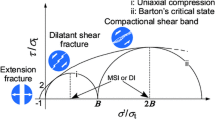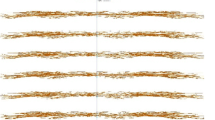Conclusions
1. The maximum water injection pressure for hydrofracturing of Blyava ores was 12.1–12.9 MPa and for hydrodisintegration, 4.5–5.5 MPa. The calculated values of these pressures differ from the experimental ones by 20–25% and 25–36% respectively, which is satisfactory for natural-scale studies.
2. The probability of hydrofracturing or hydrodisintegration of the mass depends a great deal on the distance between the packer and the borehole face. It has been demonstrated experimentally that hydrofracturing occurred at a distance of 0.1–0.6 m and only hydrodisintegration was noticed at a distance of 4–10.2 m. These data show that, all other conditions being equal, the packer (interpacker) spacing of the boreholes is of great importance for producing, in practice, some type of hydrodynamic impact on the rock mass.
3. Water injection through boreholes into the ore body under conditions of hydrofracturing and hydrodisintegration showed the real possibility of establishing a hydrodynamic link between boreholes at distances of 5 m, 10 m, and greater.
4. The technology and equipment developed by the Institute of Mining make it possible to prepare blocks of impervious ores for leaching by employing hydrofracturing and hydrodisintegration of rocks and creating in the block a borehole — slit — borehole system.
5. As a result of suffosion of the ore, slime is released intensely from the drainage boreholes, which is typical for hydrofracturing and hydrodisintegration processes and for subsequent fluid injection under pressure. This may be used to augment the performance of the borehole — slit — borehole system.
6. If conditions in the mining industry become favorable, it would be advisable to continue the operations, the essential features of which are elucidated in this paper.
Similar content being viewed by others
References
O. I. Chernov and N. G. Kyu, “Fluid-fracturing of rock masses,” Fiz.-tekh. Probl. Razrabot. Polezn. Iskop., No. 6, 81–92 (1988).
B. V. D'yakov, et al., “Directed hydrofracturing of enclosing rocks of copper ore deposits,” in: Development of Technology of Ore Extraction at Great Depths [in Russian], Institute of Mining, Siberian Branch, Academy of Sciences of the USSR, Novosibirsk (1988), pp. 65–70.
G. I. Karavaiko, et al., Role of Microorganisms in Leaching Metals from Ores [in Russian], Nauka, Moscow (1972).
L. K. Yakhontova, et al., Zone of Hypergenesis of Ore Deposits [in Russian], Moscow State University Press, Moscow (1978).
B. V. D'yakov, et al., “Preparation of ore mass for underground leaching of copper by the borehole-slit method,” Tsvetn. Metal., No. 4, 23–25 (1992).
Author information
Authors and Affiliations
Additional information
Translated from Fiziko-tekhnicheskie Problemy Razrabotki Poleznykh Iskopaemykh, No. 5, pp. 100–105, September–October, 1996.
Rights and permissions
About this article
Cite this article
Chernov, O.I., Barsukov, I.I. & D'yakov, B.V. Parameters of hydraulic fracturing and disintegration of impervious rocks while preparing blocks for leaching. J Min Sci 32, 427–432 (1996). https://doi.org/10.1007/BF02046165
Received:
Issue Date:
DOI: https://doi.org/10.1007/BF02046165




